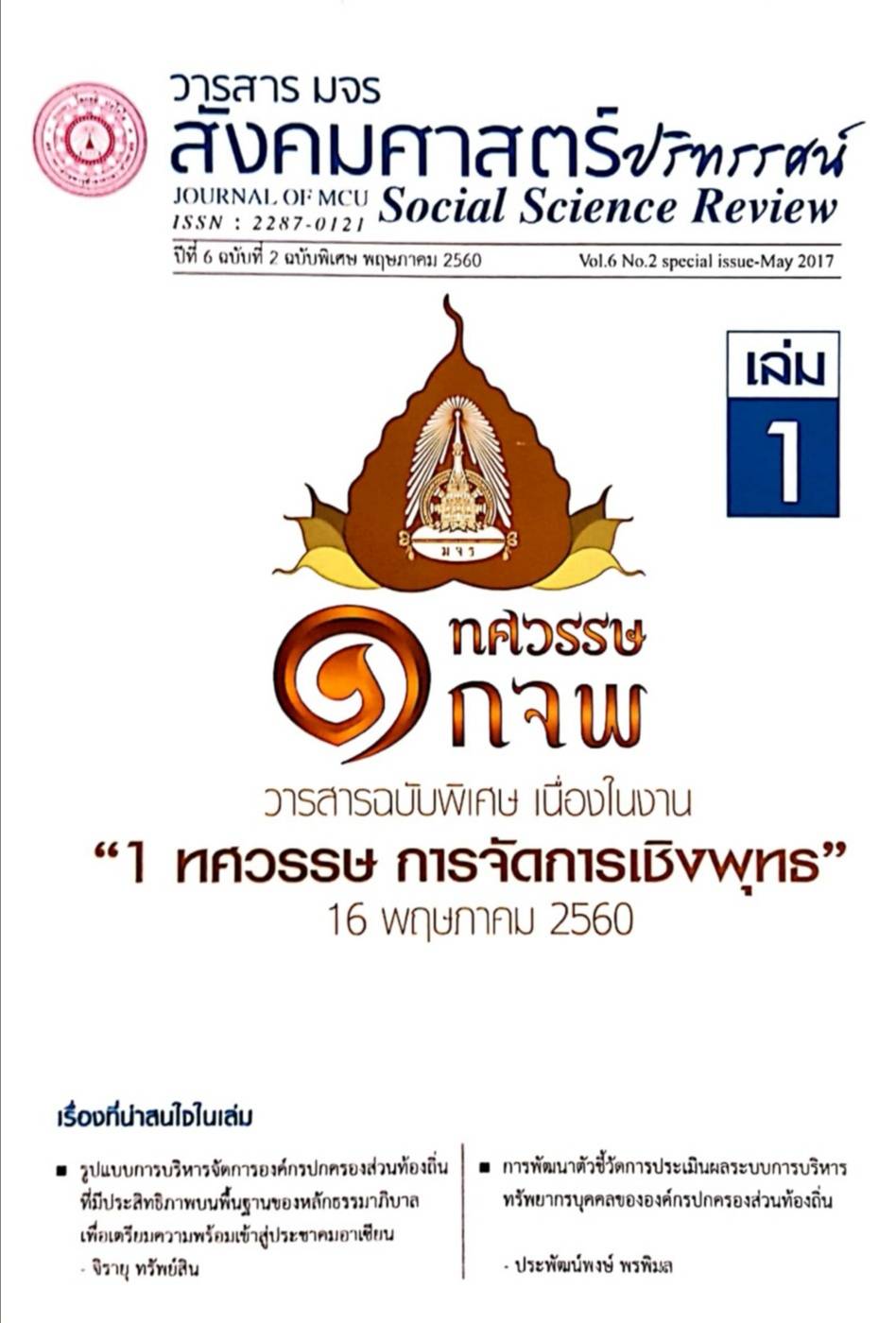บทบาทการพัฒนาชุมชนของวัดอินทาราม อำเภออัมพวา จังหวัดสมุทรสงคราม
บทคัดย่อ
บทความวิจัยครั้งนี้มีวัตถุประสงค์เพื่อ (1) ศึกษาหลักการและแนวคิดการพัฒนาชุมชน
ตามทัศนะตะวันตกและทัศนะของพระพุทธศาสนา (2) ศึกษาสภาพชุมชนของวัดอินทาราม อาเภอ
อัมพวา จังหวัดสมุทรสงคราม (3) ศึกษาบทบาทการพัฒนาชุมชนของวัดอินทาราม อาเภออัมพวา
จังหวัดสมุทรสงคราม การวิจัยครั้งนี้เป็นการศึกษาวิจัยเชิงคุณภาพ (Qualitative Research) โดยใช้
วิธีการวิจัยเชิงเอกสาร (Documentary Research) และการสัมภาษณ์แบบเจาะลึก (In-depth
Interview) กับผู้ให้ข้อมูลสาคัญ ตามลักษณะการเป็นตัวแทนของกลุ่มตัวอย่างที่เหมาะสม เพื่อให้ได้
มุมมองและแนวคิดเกี่ยวกับบทบาทการพัฒนาชุมชนของวัดอินทาราม อาเภออัมพวา จังหวัด
สมุทรสงคราม จานวน 27 รูป/คน โดยใช้เทคนิคการวิเคราะห์เนื้อหาประกอบบริบท
ผลการวิจัยพบว่า :
1. การพัฒนาชุมชนตามแนวตะวันตก เป็นการกระทาในการปรับปรุงหรือเปลี่ยนแปลง
ไปในทางที่ดีขึ้น เจริญขึ้นเป็นลาดับอย่างมีจุดมุ่งหมายร่วมกัน โดยอาศัยกระบวนการ (Process) อัน
เป็นทั้งวิธีการ (Method) และยังเป็นทั้งโครงการหรือแผนงาน (Program) อีกทั้งการเคลื่อนไหว
อย่างต่อเนื่อง (Movement) ซึ่งในหลักการดังกล่าวก็เพื่อการพัฒนาให้ชุมชนมีคุณภาพในการ
ดารงชีวิตอยู่ ทั้งด้านสังคม เศรษฐกิจ วัฒนธรรม และด้านสิ่งแวดล้อม และในทัศนะของ
พระพุทธศาสนา เป็นการพัฒนาเรียนรู้และการปฏิบัติเพื่อไปสู่ความพอดีหรือการมีดุลยภาพของชีวิต
มีความสัมพันธ์อันกลมกลืนระหว่างการดาเนินชีวิตของบุคคลกับสภาพแวดล้อมและมุ่งการกระทา
ตนและบุคคลรอบข้างให้มีความสุข รู้เท่าทัน จึงเป็นแนวทางการพัฒนาที่ยั่งยืน เพื่อจัดการแก้ปัญหา
อย่างเป็นระบบ มีความคิดวิจารณญาณตามเหตุปัจจัยด้วยตนเอง โดยอาศัยหลักธรรมเป็น
เครื่องมือในการพัฒนา
2. สภาพของชุมชนของวัดอินทารามส่วนใหญ่ประกอบอาชีพทาสวนผลไม้ เมื่อความ
เจริญขยายตัว ชุมชนนี้ได้รับผลกระทบจากการเพิ่มของผู้คนในชุมชน มีหมู่บ้านจัดสรรและร้านค้า
เป็นจานวนมาก สภาพความเป็นอยู่ของชาวชุมชนในปัจจุบัน แบ่งได้เป็น 2 ส่วน ประกอบด้วย ชาวชุมชนที่อาศัยมาแต่ดั้งเดิม ซึ่งส่วนมากเป็นครอบครัวใหญ่มีอาชีพเป็นหลักฐานมั่งคง กับชาวชุมชนที่
ย้ายถิ่นฐานมาจากต่างจังหวัด ซึ่งประกอบอาชีพรับราชการ รับจ้าง แต่ส่วนใหญ่ประกอบอาชีพ
รับจ้างทั่วไปความเป็นอยู่ของประชาชนชุมชนวัดอินทารามยังไม่หนาแน่น ไม่แออัดมากนัก สภาพ
พื้นที่ส่วนใหญ่ยังเป็นสวนผลไม้ นอกจากนั้นยังมีพื้นที่ว่างเปล่าอยู่อีกมาก คุณภาพชีวิตของคนใน
ชุมชนค่อนข้างดี เนื่องจากไม่แออัดและไร้มลพิษ
3. บทบาทการพัฒนาชุมชนของวัดอินทาราม อาเภออัมพวา จังหวัดสมุทรสงคราม มีดังนี้
1) ด้านการพัฒนาสังคม พบว่า วัดอินทาราม มีการพัฒนาในด้านจิตใจ ได้พัฒนาจิตใจของคนใน
ชุมชน เป็นผู้นาทางจิตใจของประชาชนในท้องถิ่น โดยจัดตั้งศูนย์บาบัดยาเสพติดขึ้นภายในวัด เพื่อ
เป็นการแก้พื้นฐานปัญหาของสังคม โดยใช้หลักธรรมและสมุนไพรในการรักษาผู้ที่ติดยา และยัง
ส่งเสริมจัดอบรมวิชานักธรรมและวิชาธรรมศึกษาก่อนสอบ สร้างโรงเรียน เปิดศูนย์อบรมเด็กก่อน
เกณฑ์ในวัด ช่วยอบรมบ่มนิสัยเด็กก่อนวัยเรียนเพื่อปลูกฝังคุณธรรมและศีลธรรมแต่ยังเด็ก และ
ประสานพัฒนาสังคมในด้านต่างๆ เช่น การสร้างสะพาน การสร้างถนนหลายสาย ทั้งเส้นทางหลัก
และเส้นทางเข้าหมู่บ้าน 2) ด้านการพัฒนาเศรษฐกิจ พบว่า ในชุมชนวัดอินทารามประชาชนมี
อาชีพรับจ้างและทาสวนเป็นส่วนใหญ่ มีรายได้น้อย วัดจึงได้พัฒนาด้านเศรษฐกิจ ได้แก่ จัดตั้ง
สหกรณ์น้าตาลปีบ จัดตั้งกลุ่มออมทรัพย์เพื่อการผลิต และส่งเสริมกิจกรรมร้านค้าในชุมชน เพื่อ
ส่งเสริมหลักเศรษฐกิจพอเพียง และเปิดตลาดน้าให้เกษตรกรนาสินค้าทางการเกษตรมาจาหน่าย จัด
งานเทศกาลส้มโอดี ลิ้นจี่หวาน ซึ่งสามารถสร้างรายได้ให้กับเกษตรกรได้เป็นอย่างมาก โดยไม่ผ่าน
พ่อค้าคนกลาง 3) ด้านการพัฒนาวัฒนธรรม พบว่า วัดอินทารามเป็นศูนย์รวมแหล่งความรู้แขนง
ต่างๆ เพื่อปลูกฝัง ส่งเสริมประเพณี วัฒนธรรมในรูปแบบต่างๆ เช่น ส่งเสริมประเพณีถวายสลากภัต
การตักบาตรน้าผึ้ง การตักบาตรข้าวต้มมัด การเทศน์มหาชาติเวสสันดรชาดกคาถาพันในวันสารท
ไทยทุกปี สนับสนุนการฝึกอบรมเยาวชนด้านการสืบสานประเพณีและวัฒนธรรม และท้องถิ่น
สนับสนุนการสร้างห้องสมุดประชาชนเฉลิมราชกุมารี เพื่ออนุรักษ์ความรู้ภูมิปัญญาท้องถิ่นให้เป็น
ศูนย์การเรียนรู้ภายในตาบล 4) ด้านการพัฒนาสิ่งแวดล้อม พบว่า วัดอินทารามมีการจัดการ
อย่างเหมาะสมและสอดคล้องกับสภาพปัญหาและบริบทของวัด เพื่อสร้างสภาพแวดล้อมที่ดีต่อการ
อยู่อาศัยและการประกอบกิจการต่างๆ ปูองกัน ลดเหตุราคาญและผลกระทบอื่นๆ ที่เกิดขึ้นต่อ
ชุมชน การสืบสานภูมิปัญญาท้องถิ่นเพื่อการอนุรักษ์ทรัพยากร-ธรรมชาติและสิ่งแวดล้อม เช่น จัดตั้ง
ศูนย์อนุรักษ์ปุาชายเลนและหิงห้อย จัดสถานที่ชมหิงห้อย การทาเขตอภัยทานให้ปลาอาศัยอยู่ตาม
ธรรมชาติ (วังมัจฉาปลาตะเพียน) เป็นผู้นาในการปลูกปุาชายเลน การส่งเสริมการใช้วัสดุธรรมชาติ
และสนับสนุนโครงการลงแขกลงคลอง ต่อสิ่งแวดล้อม โดยมุ่งหวังให้เกิดการปรับเปลี่ยนพฤติกรรม
หรือนาไปปรับใช้ในการดาเนินชีวิตประจาวันได้สามารถทาให้ชุมชนเกิดการปรับเปลี่ยนพฤติกรรม
หรือนาไปปรับใช้ในการดาเนินชีวิตได้ ประชาชนมีความพึงพอใจเมื่อเข้ามาในวัด
เอกสารอ้างอิง
โลกาภิวัตน์. กรุงเทพฯ : มูลนิธิซิเมนต์ไทย.
กระทรวงศึกษาธิการ. (2527). ประวัติการศึกษาของสงฆ์. กรุงเทพมหานคร : โรงพิมพ์การศาสนา
ธยาภัทร เหมวรกุล. (2548). “ปัจจัยที่สัมพันธ์กับการมีส่วนร่วมในการอนุรักษ์โบราณสถานเกาะ
เมืองพระนครศรีอยุธยา”. วิทยานิพนธ์สังคมศาสตรมหาบัณฑิต. สาขา
สังคมศาสตร์เพื่อการพัฒนา. บัณฑิตวิทยาลัย : มหาวิทยาลัยราชภัฏวไลยอลงกรณ์
ในพระบรมราชูปถัมภ์.
พระมหาสนอง อคฺคธมฺโม. (2549). “บทบาทพระสงฆ์ในการส่งเสริมชาวบ้านให้พึ่งตนเอง ศึกษา
กรณี พระครูพิพิธธรรมรส”. วิทยานิพนธ์พุทธศาสตรมหาบัณฑิต. บัณฑิตวิทยาลัย
: มหาจุฬาลงกรณราชวิทยาลัย.
พระมหาสังเวียร ปญฺญาธโร. (2550). “บทบาทของพระสงฆ์ในการนาหลักพุทธธรรมมาประยุกต์ใน
การพัฒนาเศรษฐกิจชุมชน กรณีศึกษา พระครูสุภาจารวัฒน์”. วิทยานิพนธ์พุทธ
ศาสตรมหาบัณฑิต. บัณฑิตวิทยาลัย : มหาวิทยาลัยมหาจุฬาลงกรณราชวิทยาลัย,
พระมหาเสริมชัย ชยมงฺคโล. (2538). การบริหารวัด. พิมพ์ครั้งที่ 2. กรุงเทพฯ : มูลนิธิพุทธภาวนา
วิชชาธรรมกายและธนาคารสหธนาคาร จากัดมหาชน.
พระราชวรมุนี (ประยุทธ์ ปยุตฺโต). บทบาทของพระสงฆ์ในสังคมไทยปัจจุบัน. กรุงเทพฯ : โรงพิมพ์
มหาจุฬาลงกรณราชวิทยาลัย. 2544.
พระศรีวิสุทธิโมลี (ประยุทธ์ ปยุตฺโต). (2516). บทบาทของพระสงฆ์ไทยในปัจจุบัน. กรุงเทพฯ :
วิทยานุกูล.พิสิฏฐ์ บุญไชย และทรงคุณ จันทร์. (2540). ศาสนาพุทธ : สถานภาพบทบาทต่อการเปลี่ยนแปลงใน
สังคมอีสาน. มหาสารคาม : มหาวิทยาลัยมหาสารคาม.
วรรณพร นกใหญ่. (2555). “บทบาทพระสงฆ์ในการเป็นผู้ประกอบการสังคม กรณีศึกษาวัดสวน
แก้ว จังหวัดนนทบุรี”. วิทยานิพนธ์บริหารธุรกิจมหาบัณฑิต. มหาวิทยาลัยศิลปกร.
เอนก สีหามาตย์. (2544). “บทบาทการอนุรักษ์โบราณสถานของกรมศิลปากร”. วิทยานิพนธ์
รัฐศาสตรมหาบัณฑิต. บัณฑิตวิทยาลัย : มหาวิทยาลัยธรรมศาสตร์,
ไอศูรย์ อินทร์เพชร. (2553). “บทบาทของพระสงฆ์ในการพัฒนาสังคม : ศึกษาเฉพาะกรณีพระเทพ
สาครมุนี (แก้ว สุวณฺณโชโต)”. วิทยานิพนธ์พุทธศาสตรมหาบัณฑิต. บัณฑิต
วิทยาลัย มหาวิทยาลัยมหาจุฬาลงกรณราชวิทยาลัย
ดาวน์โหลด
เผยแพร่แล้ว
รูปแบบการอ้างอิง
ฉบับ
ประเภทบทความ
สัญญาอนุญาต
ลิขสิทธิ์ (c) 2020 วารสาร มจร สังคมศาสตร์ปริทรรศน์

อนุญาตภายใต้เงื่อนไข Creative Commons Attribution-NonCommercial-NoDerivatives 4.0 International License.
เพื่อให้เป็นไปตามกฎหมายลิขสิทธิ์ ผู้นิพนธ์ทุกท่านต้องลงลายมือชื่อในแบบฟอร์มใบมอบลิขสิทธิ์บทความให้แก่วารสารฯ พร้อมกับบทความต้นฉบับที่ได้แก้ไขครั้งสุดท้าย นอกจากนี้ ผู้นิพนธ์ทุกท่านต้องยืนยันว่าบทความต้นฉบับที่ส่งมาตีพิมพ์นั้น ได้ส่งมาตีพิมพ์เฉพาะในวารสาร มจร สังคมศาสตร์ปริทรรศน์ เพียงแห่งเดียวเท่านั้น หากมีการใช้ภาพหรือตารางหรือเนื้อหาอื่นๆ ของผู้นิพนธ์อื่นที่ปรากฏในสิ่งตีพิมพ์อื่นมาแล้ว ผู้นิพนธ์ต้องขออนุญาตเจ้าของลิขสิทธิ์ก่อน พร้อมทั้งแสดงหนังสือที่ได้รับการยินยอมต่อบรรณาธิการ ก่อนที่บทความจะได้รับการตีพิมพ์ หากไม่เป็นไปตามข้อกำหนดเบื้องต้น ทางวารสารจะถอดบทความของท่านออกโดยไม่มีข้อยกเว้นใดๆ ทั้งสิ้น





